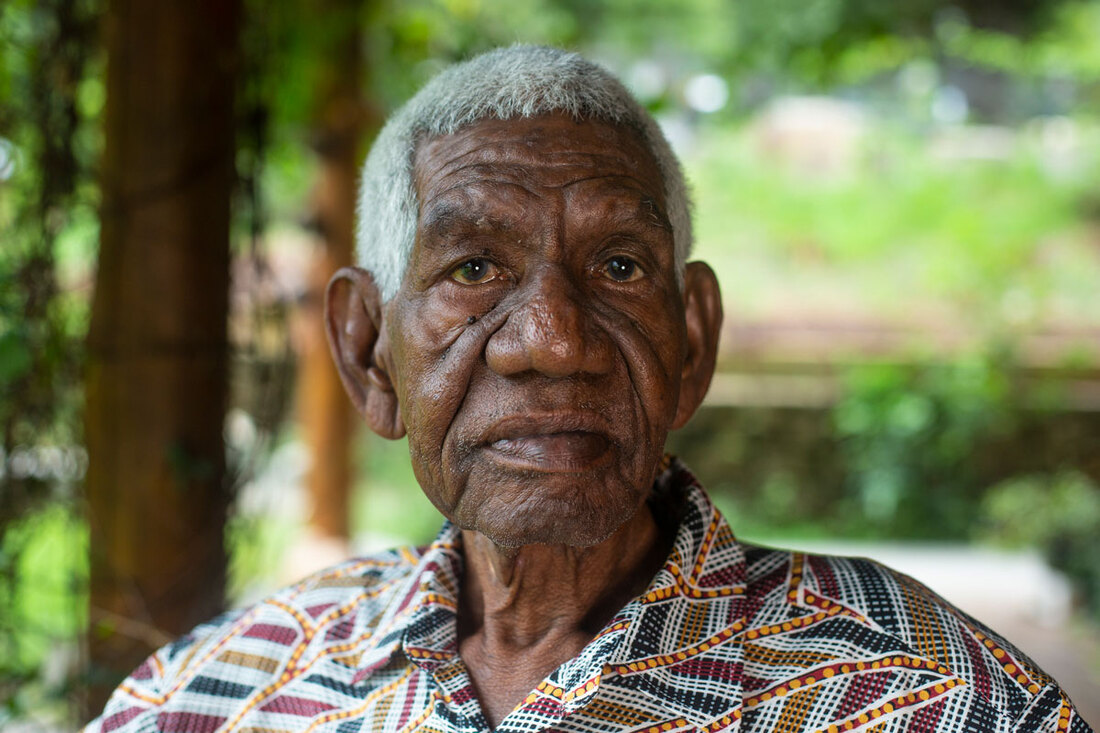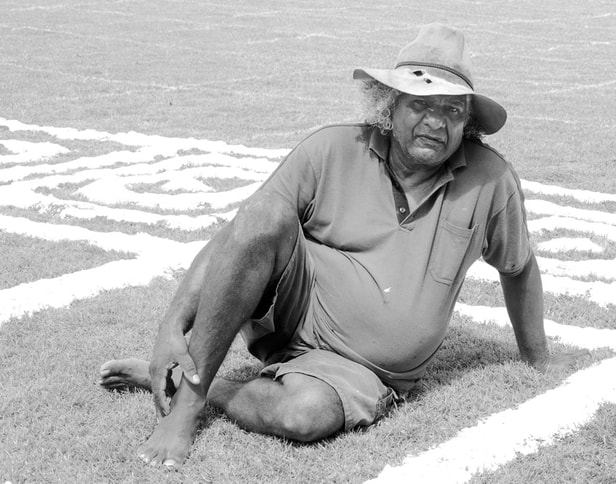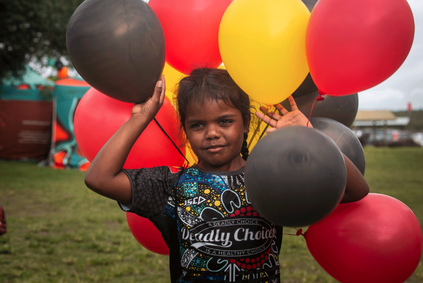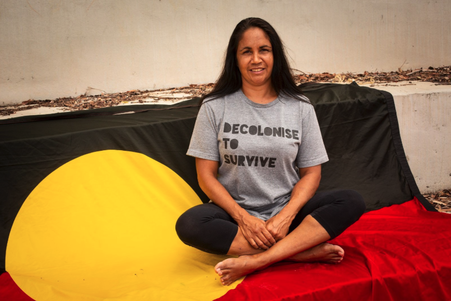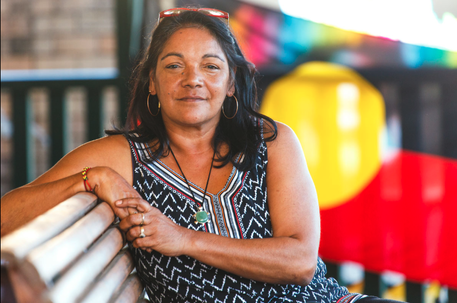Eve JefferyThis article first appeared in The Echo in January 2020 Survival Day in Byron Bay played host to a very special visitor when the Rev Dr Djiniyini Gondarra, a senior Yolngu man of the Dhurilli clan nation of Northeast Arnhem Land in the Northern Territory, spoke to the crowd gathered on Main Beach. Dr Djiniyini Gondarra has spent much of the last 50 years of his life as a civil rights activist for his people. From his early years he has walked gracefully in two worlds as a Yolngu lawman, spiritual leader, freedom fighter and community leader. 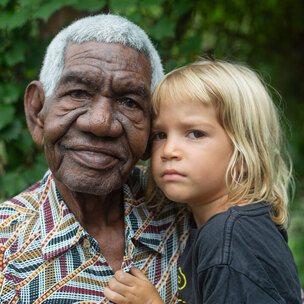 Four-year-old Rahim with his big brother Djiniyini in the Yolngu kinship system. Photo Tree Faerie. Four-year-old Rahim with his big brother Djiniyini in the Yolngu kinship system. Photo Tree Faerie. A day that everyone can celebrate Dr Gondarra believes that the day Australians celebrate being Australian should be a day that everyone can celebrate, not a day that Indigenous people are in mourning. ‘The 26th of January, this “Australia Day” we are being asked to celebrate the day Captain Phillip came and put that flag here? For us, this is the invasion day. 'I would like to see them change the date so that we can celebrate something about mourning and how we lost our great people. 'Then, I would love to see them choose another date for Australia Day when we all, whether we are Aboriginal or white or anyone who has been naturalised an Australian, can celebrate the birth of a nation, when the seven colonies came together: January 1. Land Rights Act designed to divide Dr Gondarra says he wants to see a way that Indigenous people can make a treaty with the government but believes many of the obstacles are seated in the Land Rights Act and that only people from certain parts of country can be recognised on that country. 'In this area here there are the Arakwal, the Bundjalung and you are all allies but there is a particular clause in the Land Rights Act that says in this country here, only Arakwal people can be recognised here, not somebody else. That’s written in there. That’s a divide and conquer, because, if you are allies you are stronger.’ Dr Gondarra says the way Aboriginal people work is to have allies – there are pathways to visit another nation and enter into a treaty with them. ’We enter a parley system to do business, we sell something to them and they sell something to us – there is a pathway. That’s what it’s about. What I am trying to do is find a way that the government can come and sit with us, parley with the elders of all the nations – forget about land councils, forget the people that the government have “shaped” and we are told “this is your leader”. No! This is not my leader. You shape them and give them to us. No! They are not our leaders, we didn’t chose them – send the government diplomats to talk to us, to the elders, to our chosen leaders.’ A new film made with people power Dr Gondarra is set to make a new documentary with local film director Sinem Saban who has worked closely with him for the last 12 years, in particular for her first documentary Our Generation. Ms Saban and Dr Gondarra are joining forces again for a new project, Luku Ngarra, which Saban says will not only celebrate the humble yet profound life of Dr Gondarra, but also his vision and wisdom for a better Australia. ‘This film is a sign of the times more now than ever,’ says Ms Saban. ‘But it would have been just as relevant 10 or 20 years ago, it’s just that perhaps audiences might not have been ready to actually stop and listen to the message back then. ‘Many people now are witnessing the faults of the colonial ideology we live under, the cracks are expanding. And I don’t just refer to what we have done to the environment, but also to the way our so-called democratic government system is a shambles, how we can wage a war at the drop of a hat or how the patriarchy treats women. ‘Indigenous culture and law has a lot to teach us about these things. Women are revered just as mother earth is, and priorities are not with warmongering but with societal cohesion and balance. 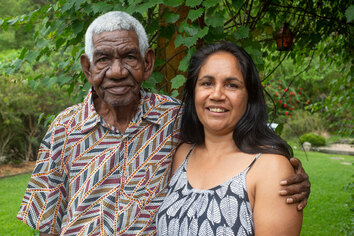 Dr Gondarra met with local Arakwal, Bundjalung woman Delta Kay on Saturday to talk about treaty and days of celebration and days of mourning. Photo Tree Faerie. Dr Gondarra met with local Arakwal, Bundjalung woman Delta Kay on Saturday to talk about treaty and days of celebration and days of mourning. Photo Tree Faerie. We need to listen to our Indigenous people ‘I can’t think of any other people that we need to be listening to right now other than our Indigenous people. More so than scientists and academics.' Ms Saban says she is forever humbled and honoured to have the trust of her Yolngu family to make this film. ‘I don’t take it lightly. I think it is imperative that when non-indigenous film-makers make films about them that they are involved in every step of the process. They are the executive decision-makers. They are the ones who make the final call. I am just the facilitator of their messages. 'If I don’t do this with full integrity, I run the risk of doing more damage than good. I am driven to make more educational resources for our classrooms, lounge rooms and global community.' Ms Saban believes wholeheartedly that funding for the film must come with no strings attached in order for the film to be made with full integrity and for this reason she and all the stakeholders have chosen to crowdfund. ‘I want to demonstrate that independent film and media is one of the most important forms of communication in our society. It is gravely at risk of being homogenised.’ Dr Gondarra, who turns 75 this week, will head home soon to continue his work forging a better Australia for all of its people. ‘I want to be a bridge-builder,’ says Dr Gondarra. ‘I want to help both sides’.
0 Comments
|
|
